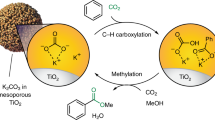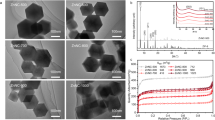Abstract
The synthesis of carboxylic acid derivatives from unsaturated hydrocarbons is an important process for the preparation of polymers, pharmaceuticals, cosmetics and agrochemicals. Despite its industrial relevance, the traditional Reppe-type carbonylation reaction using pressurized CO is of limited applicability to laboratory-scale synthesis because of: (1) the safety hazards associated with the use of CO, (2) the need for special equipment to handle pressurized gas, (3) the low reactivity of several relevant nucleophiles and (4) the necessity to employ different, often tailor-made, catalytic systems for each nucleophile. Herein we demonstrate that a shuttle-catalysis approach enables a CO- and HCl-free transfer process between an inexpensive reagent, butyryl chloride, and a wide range of unsaturated substrates to access the corresponding acid chlorides in good yields. This new transformation provides access to a broad range of carbonyl-containing products through the in situ transformation of the reactive acid chloride intermediate. In a broader context, this work demonstrates that isodesmic shuttle-catalysis reactions can unlock elusive catalytic reactions.
This is a preview of subscription content, access via your institution
Access options
Access Nature and 54 other Nature Portfolio journals
Get Nature+, our best-value online-access subscription
$29.99 / 30 days
cancel any time
Subscribe to this journal
Receive 12 print issues and online access
$259.00 per year
only $21.58 per issue
Buy this article
- Purchase on Springer Link
- Instant access to full article PDF
Prices may be subject to local taxes which are calculated during checkout



Similar content being viewed by others
References
Brennführer, A., Neumann, H. & Beller, M. Palladium-catalyzed carbonylation reactions of alkenes and alkynes. ChemCatChem 1, 28–41 (2009).
Wu, X.-F. et al. Transition-metal-catalyzed carbonylation reactions of olefins and alkynes: a personal account. Acc. Chem. Res. 47, 1041–1053 (2014).
Ali, B. E. & Alper, H. in Transition Metals for Organic Synthesis (eds Beller, M. & Bolm, C.) 113–132 (Wiley-VCH, 2008).
Kiss, G. Palladium-catalyzed Reppe carbonylation. Chem. Rev. 101, 3435–3456 (2001).
Wu, L., Liu, Q., Jackstell, R. & Beller, M. Carbonylations of alkenes with CO surrogates. Angew. Chem. Int. Ed. 53, 6310–6320 (2014).
Friis, S. D., Lindhardt, A. T. & Skrydstrup, T. The development and application of two-chamber reactors and carbon monoxide precursors for safe carbonylation reactions. Acc. Chem. Res. 49, 594–605 (2016).
Wu, L., Liu, Q., Fleischer, I., Jackstell, R. & Beller, M. Ruthenium-catalysed alkoxycarbonylation of alkenes with carbon dioxide. Nat. Commun 5, 3091 (2014).
Hermange, P. et al. Ex situ generation of stoichiometric and substoichiometric 12CO and 13CO and its efficient incorporation in palladium catalyzed aminocarbonylations. J. Am. Chem. Soc. 133, 6061–6071 (2011).
Morimoto, T. & Kakiuchi, K. Evolution of carbonylation catalysis: no need for carbon monoxide. Angew. Chem. Int. Ed. 43, 5580–5588 (2004).
Morimoto, T. et al. Rh(I)-catalyzed CO gas-free carbonylative cyclization reactions of alkynes with 2-bromophenylboronic acids using formaldehyde. Org. Lett. 11, 1777–1780 (2009).
Wang, X., Nakajima, M., Serrano, E. & Martin, R. Alkyl bromides as mild hydride sources in Ni-catalyzed hydroamidation of alkynes with isocyanates. J. Am. Chem. Soc. 138, 15531–15534 (2016).
Donets, P. A. & Cramer, N. Diaminophosphine oxide ligand enabled asymmetric nickel-catalyzed hydrocarbamoylations of alkenes. J. Am. Chem. Soc. 135, 11772–11775 (2013).
Park, H.-S., Kim, D.-S. & Jun, C.-H. Palladium-catalyzed carbonylative esterification of primary alcohols with aryl chlorides through dehydroxymethylative C–C bond cleavage. ACS Catal. 5, 397–401 (2015).
Smith, M. B. & March, J. March's Advanced Organic Chemistry: Reactions, Mechanisms, and Structure 6th edn (Wiley-Interscience, 2007).
Patai, S. The Chemistry of Acyl Halides (Interscience, 1972).
Diederich, F. & Stang, P. Metal-Catalyzed Cross-Coupling Reactions (Wiley-VCH, 1998).
Le, C. M. et al. Stereoselective synthesis of methylene oxindoles via palladium(II)-catalyzed intramolecular cross-coupling of carbamoyl chlorides. J. Am. Chem. Soc. 138, 14441−14448 (2016).
Quesnel, J. S. & Arndtsen, B. A. A palladium-catalyzed carbonylation approach to acid chloride synthesis. J. Am. Chem. Soc. 135, 16841−16844 (2013).
Quesnel, J. S., Kayser, L. V., Fabrikant, A. & Arndtsen, B. A. Acid chloride synthesis by the palladium-catalyzed chlorocarbonylation of aryl bromides. Chem. Eur. J. 21, 9550−9555 (2015).
Cernak, T. A. & Lambert, T. H. Multicatalytic synthesis of α-pyrrolidinyl ketones via a tandem palladium(II)/indium(III)-catalyzed aminochlorocarbonylation/Friedel−Crafts acylation reaction. J. Am. Chem. Soc. 131, 3124–3125 (2009).
Alderson, T. & Engelhardt, V. A. Production of acyl halides, carboxylic acids and lactones. US patent 3,065,242 (1962).
Knifton, J. F. Process for preparing halogenides of carboxylic acids. US patent 3,880,898 (1975).
Fang, X., Yu, P. & Morandi, B. Catalytic reversible alkene-nitrile interconversion through controllable transfer hydrocyanation. Science 351, 832–836 (2016).
Bhawal, B. N. & Morandi, B. Catalytic transfer functionalization through shuttle catalysis. ACS Catal. 6, 7528−7535 (2016).
Murphy, S. K., Park, J.-W., Cruz, F. A. & Dong, V. M. Rh-catalyzed C–C bond cleavage by transfer hydroformylation. Science 347, 56–60 (2015).
Landis, C. R. Construction and deconstruction of aldehydes by transfer hydroformylation. Science 347, 29–30 (2015).
Park, Y. J., Park, J.-W. & Jun, C.-H. Metal−organic cooperative catalysis in C−H and C−C bond activation and its concurrent recovery. Acc. Chem. Res. 41, 222–234 (2008).
Kamer, P. C. J., van Leeuwen, P. W. N. M. & Reek, J. N. H. Wide bite angle diphosphines: Xantphos ligands in transition metal complexes and catalysis. Acc. Chem. Res. 34, 895–904 (2001).
Kamigaito, M., Ando, T. & Sawamoto, M. Metal-catalyzed living radical polymerization. Chem. Rev. 101, 3689–3746 (2001).
Waldo, J. P., Mehta, S. & Larock, R. C. Room temperature ICl-induced dehydration/iodination of 1-acyl-5-hydroxy-4,5-dihydro-1H-pyrazoles. A selective route to substituted 1-acyl-4-iodo-1H-pyrazoles. J. Org. Chem. 73, 6666–6670 (2008).
Urawa, Y., Nishiura, K., Souda, S. & Ogura, K. A convenient method for preparing aromatic α,β-unsaturated ketones from α,β-unsaturated acyl chlorides and arylboronic acids via Suzuki–Miyaura type coupling reaction. Synthesis 2882–2885 (2003).
Scheiper, B., Bonnekessel, M., Krause, H. & Fürstner, A. Selective iron-catalyzed cross-coupling reactions of Grignard reagents with enol triflates, acid chlorides, and dichloroarenes. J. Org. Chem. 69, 3943–3949 (2004).
Lee, H.-S., Park, J.-S., Kim, B. M. & Gellman, S. H. Efficient synthesis of enantiomerically pure β2-amino acids via chiral isoxazolidinones. J. Org. Chem. 68, 1575–1578 (2003).
Monteil, T. et al. Process for synthesizing N-(mercaptoacyl) amino acid derivatives from alpha-substituted acrylic acids. US patent 0055645 A1 (2002).
Liu, Y., Virgil, S. C., Grubbs, R. H. & Stoltz, B. M. Palladium-catalyzed decarbonylative dehydration for the synthesis of α-vinyl carbonyl compounds and total synthesis of (–)-aspewentins A, B, and C. Angew. Chem. Int. Ed. 54, 11800–11803 (2015).
Gooßen, L. J. & Rodriguez, N. A mild and efficient protocol for the conversion of carboxylic acids to olefins by a catalytic decarbonylative elimination reaction. Chem. Commun. 724–725 (2004).
Tsuji, J. & Ohno, K. Organic syntheses by means of noble metal compounds. XXXIV. Carbonylation and decarbonylation reactions catalyzed by palladium. J. Am. Chem. Soc. 90, 94−98 (1968).
Acknowledgements
We thank E. M. Carreira, B. Bhawal, M. Schafroth, Z. K. Wickens and N. Armanino for critical proofreading of this manuscript. Generous funding from the Max-Planck-Society, the Max-Planck-Institut für Kohlenforschung, the Otto Röhm Gedächtnisstiftung and the Fonds der Chemischen Industrie are acknowledged. We thank B. List for sharing analytical equipment and our mass spectrometry department for technical assistance.
Author information
Authors and Affiliations
Contributions
B.M. and X.F. conceived the project and designed the experiments. X.F. and B.C. performed the experiments and analysed the data. B.M. and X.F. wrote the manuscript. All the authors discussed the results and commented on the manuscript.
Corresponding author
Ethics declarations
Competing interests
The authors declare no competing financial interests.
Supplementary information
Supplementary information
Supplementary information (PDF 9319 kb)
Rights and permissions
About this article
Cite this article
Fang, X., Cacherat, B. & Morandi, B. CO- and HCl-free synthesis of acid chlorides from unsaturated hydrocarbons via shuttle catalysis. Nature Chem 9, 1105–1109 (2017). https://doi.org/10.1038/nchem.2798
Received:
Accepted:
Published:
Issue Date:
DOI: https://doi.org/10.1038/nchem.2798
This article is cited by
-
A metal-catalysed functional group metathesis approach to the carbon isotope labelling of carboxylic acids
Nature Chemistry (2024)
-
Palladium-catalyzed regiodivergent hydrochlorocarbonylation of alkenes for formation of acid chlorides
Nature Communications (2023)
-
Zeolites as equilibrium-shifting agents in shuttle catalysis
Nature Catalysis (2023)
-
Palladium-catalysed carboformylation of alkynes using acid chlorides as a dual carbon monoxide and carbon source
Nature Chemistry (2021)
-
Fragmentation and reassembly
Nature Chemistry (2021)



